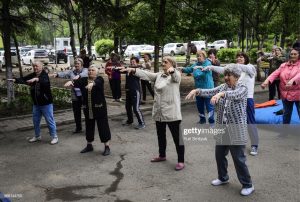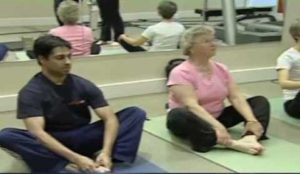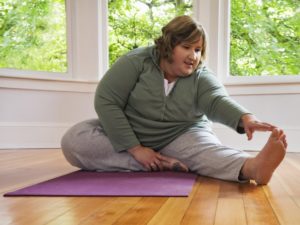By John M. de Castro, Ph.D.
“For patients at risk of metabolic syndrome and type 2 diabetes, the Chinese exercises Tai Chi and Qigong may improve clinical parameters associated with the conditions.” – Charles Bankhead
Metabolic Syndrome is a major risk factor for cardiovascular disease and diabetes. It generally results from overweight and abdominal obesity and includes high blood pressure, insulin resistance and elevation of plasma cholesterol and triglycerides. It is highly associated with obesity and type-2 diabetes. Metabolic Syndrome incidence has been rising rapidly and it currently affects 34% of U.S. adults. The simplest treatment is simply exercise and weight loss. Also, mindfulness techniques have been shown to be effective in treating Metabolic Syndrome.
Obviously, there is a need for effective treatments to prevent or treat obesity and metabolic syndrome. But, despite copious research and a myriad of dietary and exercise programs, there still is no safe and effective treatment. Qigong practice is both an exercise and a mindfulness practice. It has been found to be effective for an array of physical and psychological issues. It appears to strengthen the immune system, reduce inflammation, and improve cardiovascular function. So, with indications of so many benefits it makes sense to step back and review the research and summarize what is known about the effects of Qigong training on metabolic syndrome.
In today’s Research News article “Wuqinxi Qigong as an Alternative Exercise for Improving Risk Factors Associated with Metabolic Syndrome: A Meta-Analysis of Randomized Controlled Trials.” (See summary below or view the full text of the study at: https://www.ncbi.nlm.nih.gov/pmc/articles/PMC6517947/), Zou and colleagues review, summarize, and perform a meta-analysis on the published randomized controlled trials investigating the effectiveness of Qigong practice for the treatment of metabolic syndrome. They identified 9 published research studies that included a total of 628 participants.
They report that the published research found that Qigong practice produced significant reductions in systolic and diastolic blood pressure, total plasma triglycerides and cholesterol, including reductions in low density lipoproteins (LDL Cholesterol) and high density lipoproteins (HDL Cholesterol). In addition, they found that the longer the duration of practice the greater the decreases in diastolic blood pressure, total plasma triglycerides and cholesterol, and low density lipoproteins (LDL Cholesterol).
The findings are exciting as they suggest that Qigong practice is a safe and effective treatment for the symptoms of metabolic syndrome and the longer the practice continues the greater the benefits. Qigong is a gentle and safe mindfulness practice. It is appropriate for all ages including the elderly and for individuals with illnesses that limit their activities or range of motion. It is inexpensive to administer, can be performed in parks or alone, at home or in a facility, and can be quickly learned. In addition, it can be practiced in social groups. This can make it fun, improving the likelihood of long-term engagement in the practice. So, Qigong practice would appear to be an excellent gentle practice to treat the symptoms of metabolic syndrome.
So, improve metabolic syndrome with Qigong.
“Qigong exercise has shown promising results in clinical experience and in randomized, controlled pilot studies for affecting aspects of T2DM including positive associations between participation in Qigong and blood glucose, triglycerides, total cholesterol, weight, BMI and insulin resistance.” – Guan-Cheng Sun
CMCS – Center for Mindfulness and Contemplative Studies
This and other Contemplative Studies posts are also available on Google+ https://plus.google.com/106784388191201299496/posts and on Twitter @MindfulResearch
Study Summary
Zou, L., Zhang, Y., Sasaki, J. E., Yeung, A. S., Yang, L., Loprinzi, P. D., … Mai, Y. (2019). Wuqinxi Qigong as an Alternative Exercise for Improving Risk Factors Associated with Metabolic Syndrome: A Meta-Analysis of Randomized Controlled Trials. International journal of environmental research and public health, 16(8), 1396. doi:10.3390/ijerph16081396
Abstract
Background: The improvement of living standards has led to increases in the prevalence of hypokinetic diseases. In particular, multifactorial complex diseases, such as metabolic syndrome, are becoming more prevalent. Currently, developing effective methods to combat or prevent metabolic syndrome is of critical public health importance. Thus, we conducted a systematic review to evaluate the existing literature regarding the effects of Wuqinxi exercise on reducing risk factors related to metabolic syndrome. Methods:Both English- and Chinese-language databases were searched for randomized controlled trials investigating the effects of Wuqinxi on these outcomes. Meanwhile, we extracted usable data for computing pooled effect size estimates, along with the random-effects model. Results: The synthesized results showed positive effects of Wuqinxi exercise on systolic blood pressure (SBP, SMD = 0.62, 95% CI 0.38 to 0.85, p< 0.001, I2 = 24.06%), diastolic blood pressure (DBP, SMD = 0.62, 95% CI 0.22 to 1.00, p < 0.001, I2 = 61.28%), total plasma cholesterol (TC, SMD = 0.88, 95% CI 0.41 to 1.36, p < 0.001, I2 = 78.71%), triglyceride (TG, SMD = 0.87, 95% CI 0.49 to 1.24, p < 0.001, I2 = 67.22%), low-density lipoprotein cholesterol (LDL-C, SMD = 1.24, 95% CI 0.76 to 1.72, p < 0.001, I2 = 78.27%), and high-density lipoprotein cholesterol (HDL, SMD = 0.95, 95% CI 0.43 to 1.46, p < 0.001, I2 = 82.27%). In addition, regression results showed that longer-duration Wuqinxi intervention significantly improved DBP (β = 0.00016, Q = 5.72, df = 1, p = 0.02), TC (β = −0.00010, Q = 9.03, df = 1, p = 0.01), TG (β = 0.00012, Q = 6.23, df = 1, p = 0.01), and LDL (β = 0.00011, Q = 5.52, df = 1, p = 0.02). Conclusions: Wuqinxi may be an effective intervention to alleviate the cardiovascular disease risk factors of metabolic syndrome.
https://www.ncbi.nlm.nih.gov/pmc/articles/PMC6517947/









